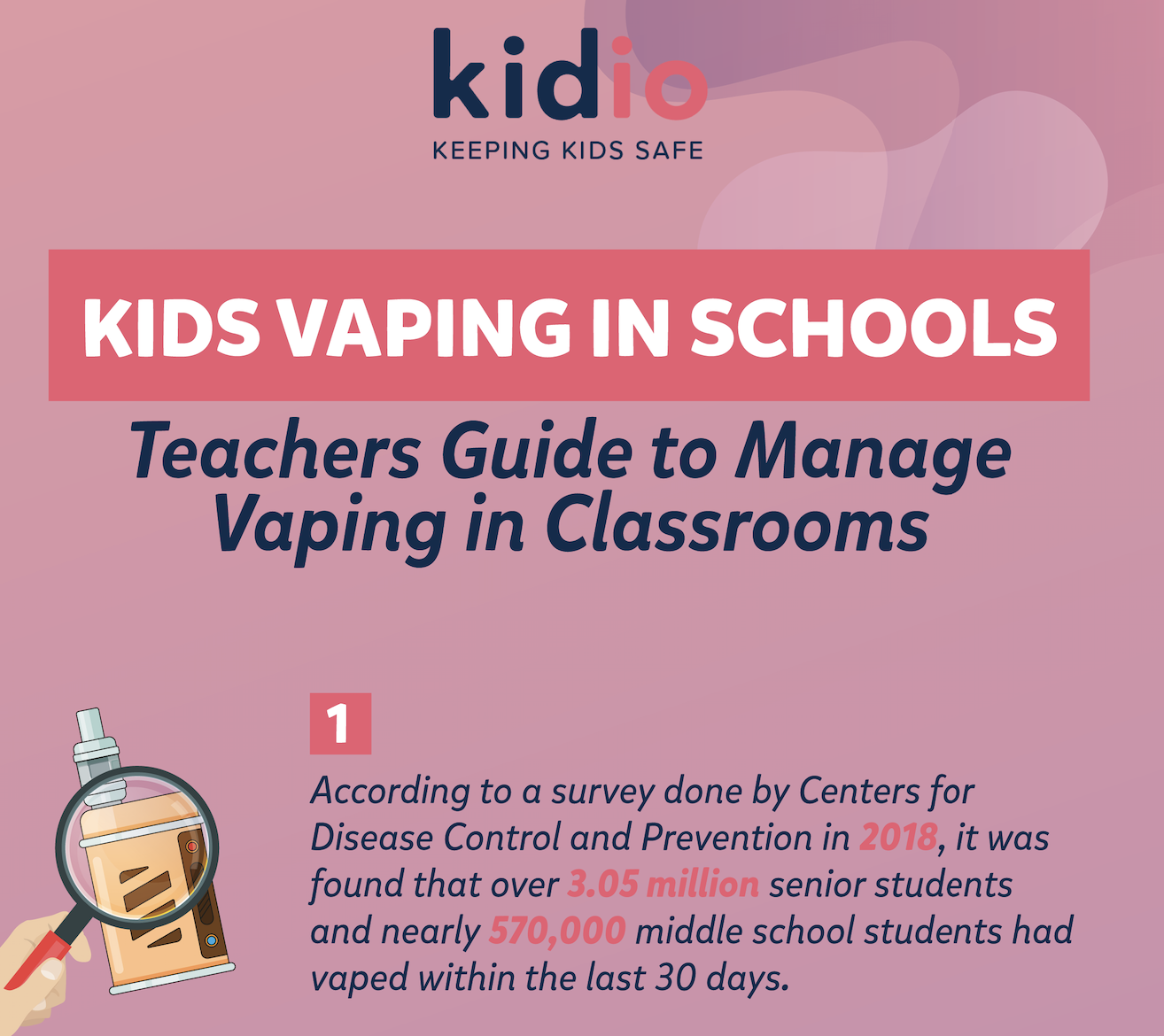While e-cigarettes have been in existence for more than a decade. It is not until some years ago that their use started increasing at an alarming rate, especially among students.
Vaping is becoming a pandemic in k-12 schools in the US. Despite the
efforts from teachers, administrators, state officials, and health practitioners, it seems like the advice is falling on deaf ears. This menace of Vaping in schools is skyrocketing every single day. Here is some comprehensive information about Kids Vaping in Schools to serve as a Teacher’s Guide.
Data Showing E-cigarette / Vaping / Juuling among Kids in Schools
According to a survey done by The Centers for Disease Control and Prevention in 2018, it was found that over 3.05 million senior students and nearly 570,000 middle school students had vaped within the last 30 days. A study by the National Institute of Health in 2017 also found that more than
one in four high-school seniors reported having vaped in the previous year. It also said that16.6% agreed that they had puffed an e-cigarette in the last 30 days.
The US Food and Drug Administration announced that it is proposing new measures against flavored nicotine products. They determined that vaping had increased by nearly 80% for the senior students and 50% among middle-level students since last year. These proposals seek to remove flavored e-cigarette products from the shelves and clamp online stores that are easily accessible to minors.
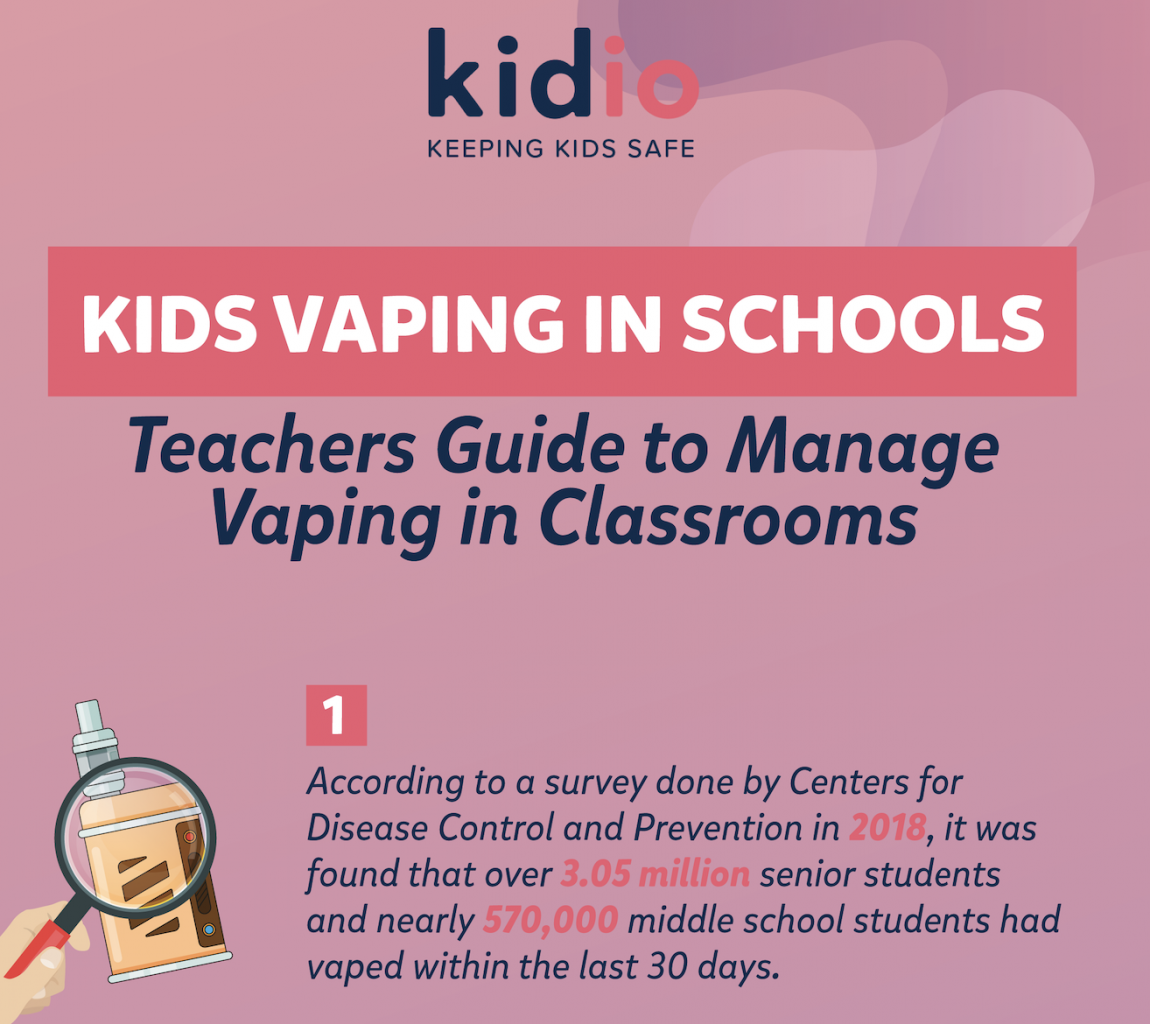
Many of the teens using these devices don’t understand that they contain highly addictive nicotine. A survey by the Truth Initiative discovered that up to 63 percent of all 15 to 24-year-old that vaped in the previous 30 days didn’t know that they enjoyed products that contain highly concentrated nicotine.
Why the Sudden Increase?
The rise in the number of students using e-cigarettes is attributable to several things. For starters, the devices come in shapes of popular items which are easy to conceal in pockets or sleeves. For instance, the most popular brand, Juul, looks like a USB drive and its small size means that it can be hidden even in the smallest of places. Additionally, they come with sweet scents and flavorings which are only attractive to the teens. The scent of sweet mango or fresh mint in student’s bathrooms, car park, and schoolbus can indicate evidence for the spike in the use of e-cigarettes by middle and high school students.
Social Media Influence On Vaping Among Kids
The glamorous images on social media of Kids Vaping in Schools have led to many kids wanting to try the e-cigarettes. These kids are unaware of the risks involved. The glorification of vaping in society especially on social media is a problem. It is therefore not unlikely that the devices are increasingly showing up in classrooms, parking lots, and school bathrooms.
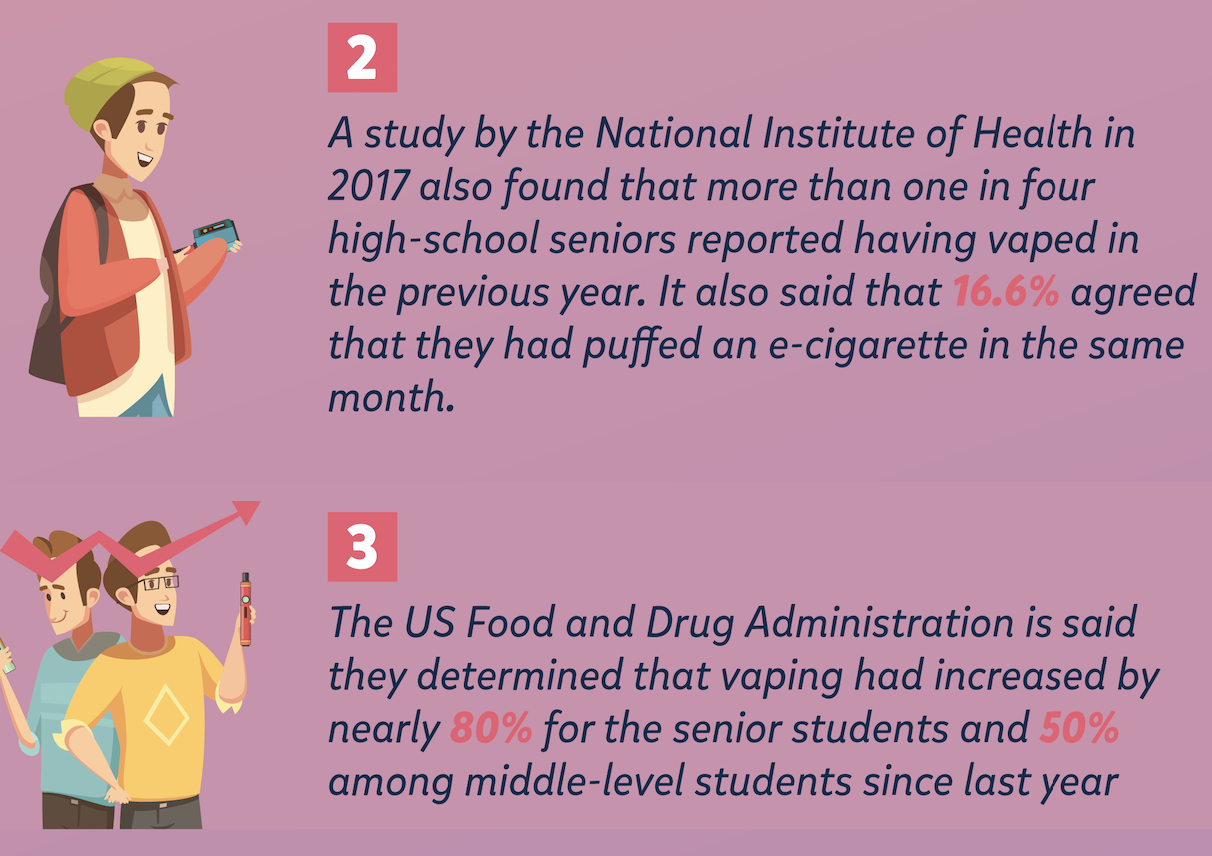
Experts and health advocates are worried that history is about to repeat itself with nicotine addiction among youths. A few years ago, the US achieved a record low number of youth smoking traditional cigarettes. And with the spike in the use of e-cigarettes, it seems like we are
getting back to the old times. We are creating a generation that is highly
addicted to nicotine.
Kids Vaping in Schools continues to become a thorn in the flesh for many schools across the US. And teachers, administrators, parents, as well as health practitioners, are scrambling to address it before it becomes more serious. Federal officials and other stakeholders are evaluating their options in the fight against the use of e-cigarettes by teens. The influencers best-suited to address this emerging problem are Educators.
Why Everyone Should Be Concerned About Kids Vaping
Vaping brands market their e-cigarettes as a green alternative to smoking. Studies have however revealed that the e-liquids can predispose some harmful effects, especially to those aged between 15-24 years. When advertisements say that vaping is not as bad as smoking, teens mistakenly think there is no harm, and they are just inhaling pleasant gases.
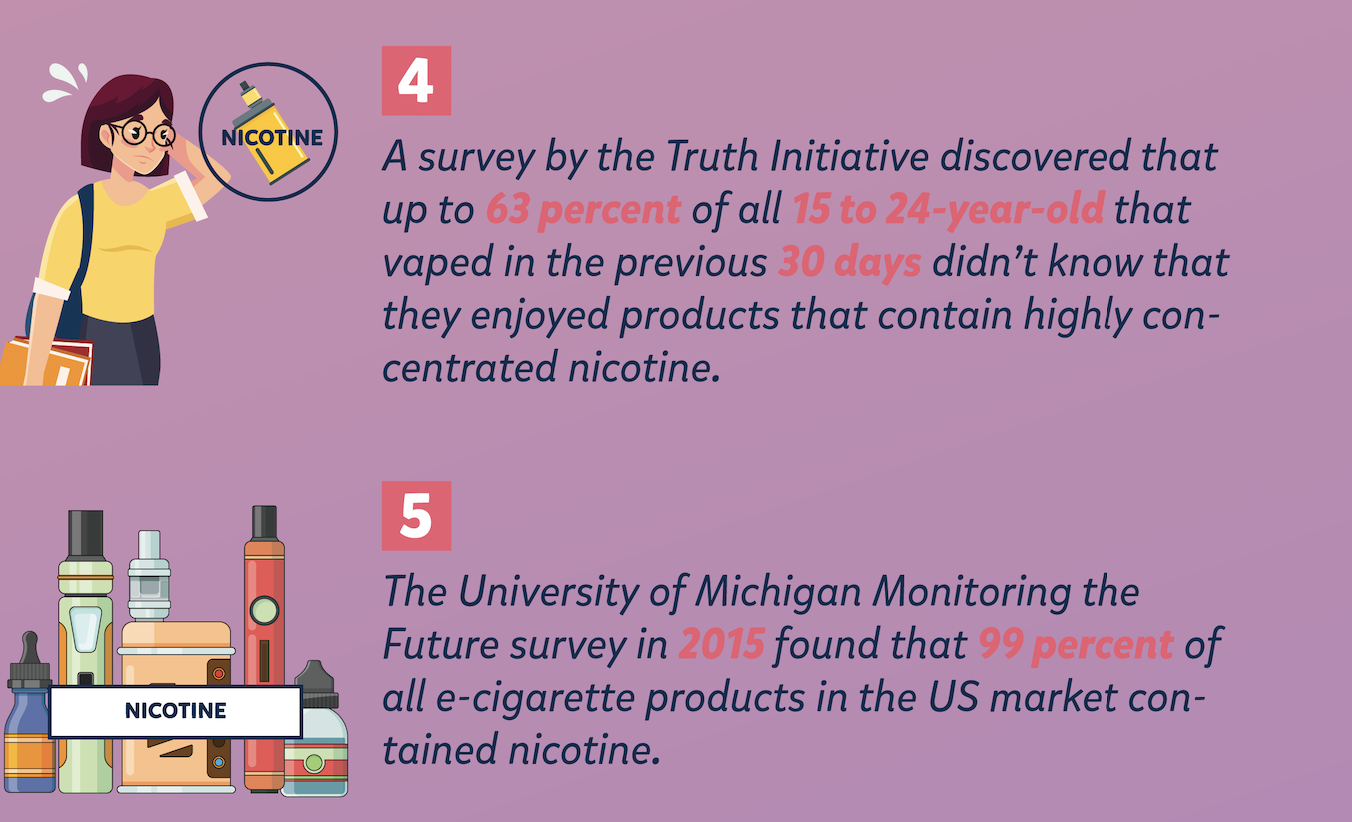
However, this is not the case, according to research. The University of Michigan monitoring the future survey in 2015 found that 99 percent of all e-cigarette products in the US market contained nicotine. A study was conducted on 12th graders who vaped but were previously non-smokers. This group was four times more likely to disregard the perception that cigarettes pose significant health risks.
Health Risks of Vaping/Juuling
Nicotine poses some detrimental health risks to young people. Most kids erroneously assume that nicotine is only found in cigarettes. They fail to realize that even puffing e-cigarette can introduce nicotine into their bodies. Consumernotice.org has written an exhaustive article on the health risks of vaping that can be read at this link. Some of the potentially harmful effects of Kids Vaping in Schools include:
Brain Risks
The part of the brain responsible for impulse control and decision making is not fully developed during adolescence. Therefore, exposing underdeveloped brains to nicotine and other drugs can lead to some long-term effects. These effects like alteration of how synapses are formed, permanent lowering of impulse control, and mood disorders among others.
Addiction
Individuals below the age of 25 get easily addicted to things as their brains are still growing. This is because when you learn a new skill or create a memory, synapses or connections are developed between brain cells. Since synapses are built faster in young people’s brains than in adults, they can easily get inclined as addiction is a form of learning too.
Behavioral Risks
The use of E-cigarettes can also lead to teens indulging in other tobacco products such as regular cigarettes, smokeless tobacco, and cigars. They can also develop an inclination for marijuana and other substances that can be vaped.

E-cigarettes may contain other harmful substances
E-cigarettes include aerosols which may contain toxic chemicals. Some of the contents like ultrafine particles that can be deposited deep into the lungs when inhaled. It may also contain flavoring chemicals such as diacetyl which is linked to lung diseases. Another risk that e-cigarettes may cause is explosions and fires. Overcharging of batteries have also caused incidences of fire in classrooms.
The Bottom line is that young people should know that vaping can ntroduce harmful substances into your body, and cause more detrimental
health complications.
What Are Teachers & Educators Doing, & What More Should They Do To Get E-Cigarettes Out Of Schools?
The sudden increase in incidences of Kids Vaping in Schools has warranted many schools to take various actions to curb the menace. The Independent recently reported that a Nebraska school district is contemplating nicotine tests. This random nicotine tests will be for students aged 12 to 18 years. The tests will be limited to those who wish to engage in extracurricular activities or join school societies. There are also looking to install Wi-Fi-enabled vape detectors. This is a new technology that involves the use of devices that resembles smoke detectors. They are designed to detect any vapor from an e-cigarette. However, because the vape detectors are relatively expensive, some schools are going for
dummies to act as deterrents.
It was also reported that the Conejo Valley Unified School District in Southern California’s punishment of students by suspension proved futile. They would now start sending students to a four-hour weekend class. It will discuss e-cigarette brands marketing techniques and the dangers of vaping.
Stakeholders and educators have done a lot to reverse this trend of Vaping. However, it seems like it is not enough. The uptick in e-cigarette use is still soaring. For this reason, there is a need for more articulate and coordinated efforts from all education stakeholders, especially teachers, to get Juul out of schools.
How Can We Stop Kids Vaping In Schools?
Vaping 101
The greatest hindrance to solving the e-cigarette epidemic in schools is the lack of knowledge and teacher’s awareness about the scale of the problem. The National Institute of Health discovered that many of the students don’t understand the content of e-cigarettes. When senior secondary students were asked to share their thoughts on vaping, more than 50% retorted that “it was just flavoring”. Therefore, student education and awareness are important before teachers and school administrators start using punitive measures to punish students who are caught vaping. Read this ‘Kids Vaping in Schools- Teacher’s Guide’ and include it in your study material for awareness.
The fact that the media and adults perceive e-cigarettes as harmless is part of the problem. Teens don’t understand what it is all about. They think they are blowing flavored water vapor or just following a trend. Therefore, before castigating the students, teachers should educate them
on the various issues that relate to vaping. There are multiple things that schools can do to curb vaping.
For instance, non-profit organizations such as CATCH My Breath have come up with a free Curriculum for middle and high school students. The program seeks to educate students on the chemicals in vaping pods and how they can affect their well-being. It also makes students aware of the disguised and intelligent marketing techniques used by vaping brands, as well as provides them with the necessary strategies to overcome and move past the social media hype.
Have An Anonymous Reporting Tool
Offering an anonymous channel will encourage the students to notify the administrators when they spot any behavior change or any use of e-cigarettes in the school compound. Tools such as Kidio Tip Line will
help you identify vaping problem early enough. This will see that you can take the necessary steps to resolve it before it becomes a problem. The main focus of having a reporting tool is to encourage early intervention and prevention through proper awareness and communication. Besides helping to reduce vaping by kids in schools, the technique can also be used to report other incidences. This includes things like fights, harassment, drug use, and other things that can threaten the safety of students.
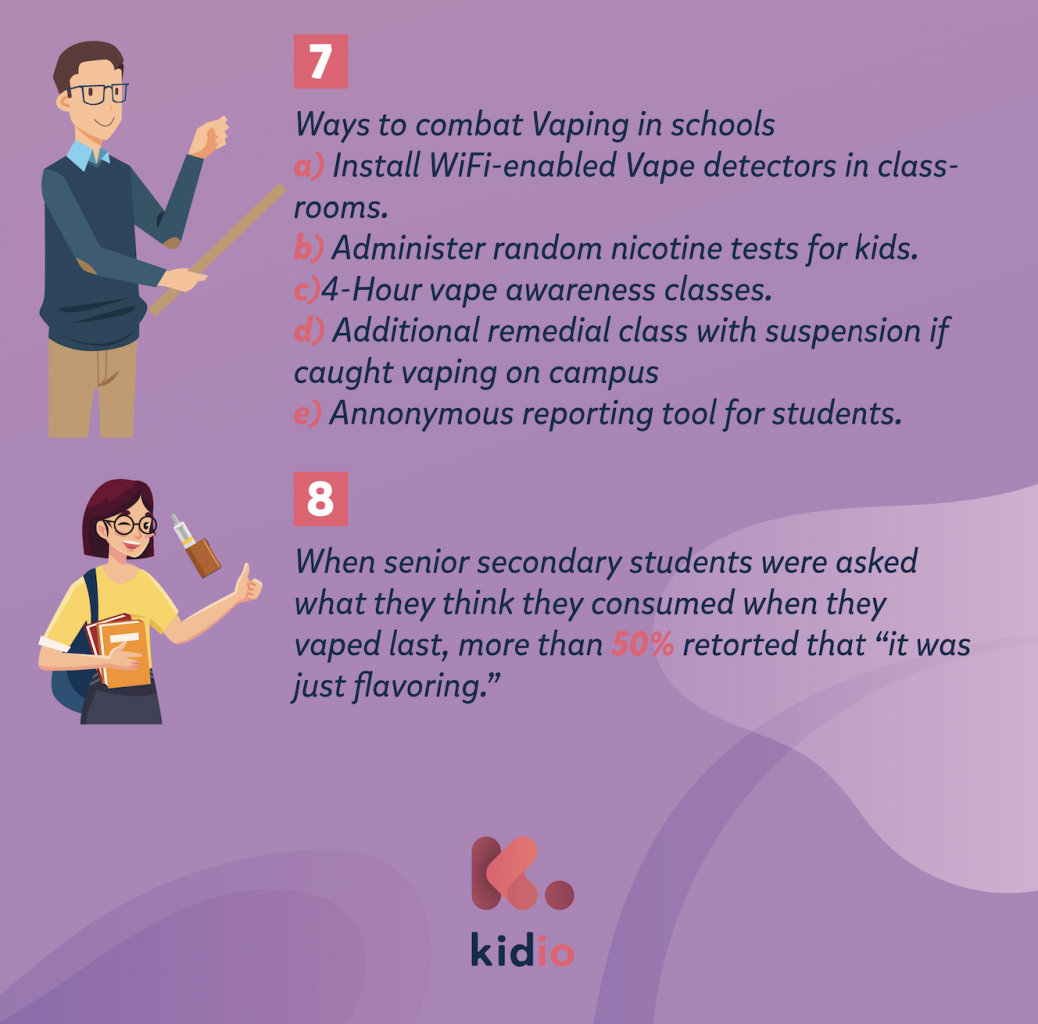
Peer-To-Peer Education
Peer-to-peer education programs used in school are still the most effective. They were popular in fighting things like smoking in schools. While they proved to be very useful in the past, there are concerns that traditional programs don’t work today. Programs that advocate for the eradication of Juuls in schools need a fresh approach as the technology, and the chemistry involved in vaping is entirely new. With devices becoming smaller, prettier, and sweeter, it will require immense resources to create programs that help fight this vice.
It is imperative to avoid teachers’ led peer programs. Research indicates that having students lead and deliver messages on e-cigarettes
avoidance can be fun to their peers. Students seem to heed to the advice
offered by their respected peers as they understand their problems better. It would make more sense for middle-level students to hear that vaping is harmful from their role model who is a senior basketball player than from a teacher. Therefore, if you are creating peer-peer programs, remember to stay abreast with changes in technology as well as involve students from the highest level. This ‘Kids Vaping in Schools- Teacher’s Guide’ should be used as resource.
Involve The Parents
Many parents may lack an in-depth understanding of e-cigarettes. However, if they are privy to this Kids Vaping in Schools Guide, they can be instrumental in the fight against the use of vapes by students. Considering the tremendous influence that parents have on their kids, they should be part and parcel of any discussions that surround vaping. Schools can conduct parent training or make presentations that relate to vaping during monthly or annual parent meetings. Teachers should also encourage
parents to communicate and interact freely with their kids so that they can
report to them any incidences or detect any behavior change.
It is also vitally crucial to involve parents in discipline cases that relate to their kids vaping. For instance, when a student is caught vaping, educators can recommend remedial classes to be attended by their parents as well.
It Will Take A Community To Eradicate Kids Vaping In Schools
Although much of the burden lies on the shoulders of educators, all stakeholders must come together and play their part if this fight is to be won. Sanctity of products sold to adolescents should also be the responsibility of the E-Cigarette companies. Additionally, state and public health officials should enact and advocate for stringent FDA regulations on these devices. These include things such as cracking down sites that sell e-cigarettes to students and raising the age of buying a vaping device to 21
years. There are reports that even the most popular vaping brand, Juul has
joined the fight by setting aside over $30 million to help in advocating youth
prevention. However, most people are skeptical, and they are saying that this could be another of their publicity stunts since nearly half of their customers are between 15 and 24.
Whichever the case, teachers and administrators should stay at the top of the current issues affecting today’s teens. They should lead the way when it comes to getting e-cigarettes out of schools. With collective and well-coordinated efforts from all concerned parties, without any doubt, it will
be easier to help students stay healthy and make informed decisions. Please distribute and share this Kids Vaping in Schools- Teacher’s Guide to all teachers ion your schools.

